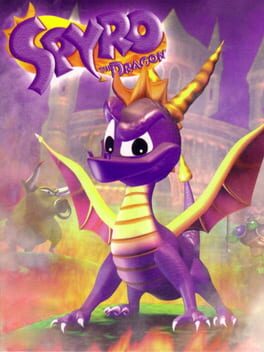Spyro the Dragon's biggest strength appears to be a certain minimalism to its design and kit. It's in stark contrast to the other 1998 collectathon, Banjo-Kazooie: where that game clutters your moveset up with tons of abilities that mostly fail to impact the platforming, Spyro manages to use the glide, charge and flame in interesting ways that often directly impact the platforming experience.
The result is an extremely laser-focused 3D platformer that offers an experience on par with, but stands out against Mario's best moments, yet feels modern and innovative in ways that Crash Bandicoot was too traditional to be.
Where Super Mario 64 strived for sheer mobility and options for fluid, nuanced movement, Spyro goes for geometry, and using that as part of the player's kit as much as the controls themselves.
Picture a ledge that Spyro couldn't reach with his jump: Mario would find a way onto it no matter what, be it through a triple jump into a wall kick, a well-timed turbo nozzle jump, or a cap vault roll chained into a cap bounce.
Spyro would have to explore the rest of the level, examine its geometry and determine the best point to jump off of and glide onto in order to find a way onto this very trivial platform...
But that's what makes it work so well. What would be small distances in the other most acclaimed 3D platformers is so meaningful - Spyro the Dragon achieves more with less, making the most out of its sense of space in a way that feels inherited straight from Sonic the Hedgehog.
Maybe that's why I feel like this was the true contender for Mario's most formidable rival in the late 1990's.
The result is an extremely laser-focused 3D platformer that offers an experience on par with, but stands out against Mario's best moments, yet feels modern and innovative in ways that Crash Bandicoot was too traditional to be.
Where Super Mario 64 strived for sheer mobility and options for fluid, nuanced movement, Spyro goes for geometry, and using that as part of the player's kit as much as the controls themselves.
Picture a ledge that Spyro couldn't reach with his jump: Mario would find a way onto it no matter what, be it through a triple jump into a wall kick, a well-timed turbo nozzle jump, or a cap vault roll chained into a cap bounce.
Spyro would have to explore the rest of the level, examine its geometry and determine the best point to jump off of and glide onto in order to find a way onto this very trivial platform...
But that's what makes it work so well. What would be small distances in the other most acclaimed 3D platformers is so meaningful - Spyro the Dragon achieves more with less, making the most out of its sense of space in a way that feels inherited straight from Sonic the Hedgehog.
Maybe that's why I feel like this was the true contender for Mario's most formidable rival in the late 1990's.
2 Comments
Thank you so much! I find my best reviews end up adopting the personality I got out of the game in question - and it only seemed fair to honor such a concise game with brevity of my own.

aalc
2 years ago